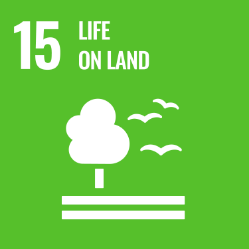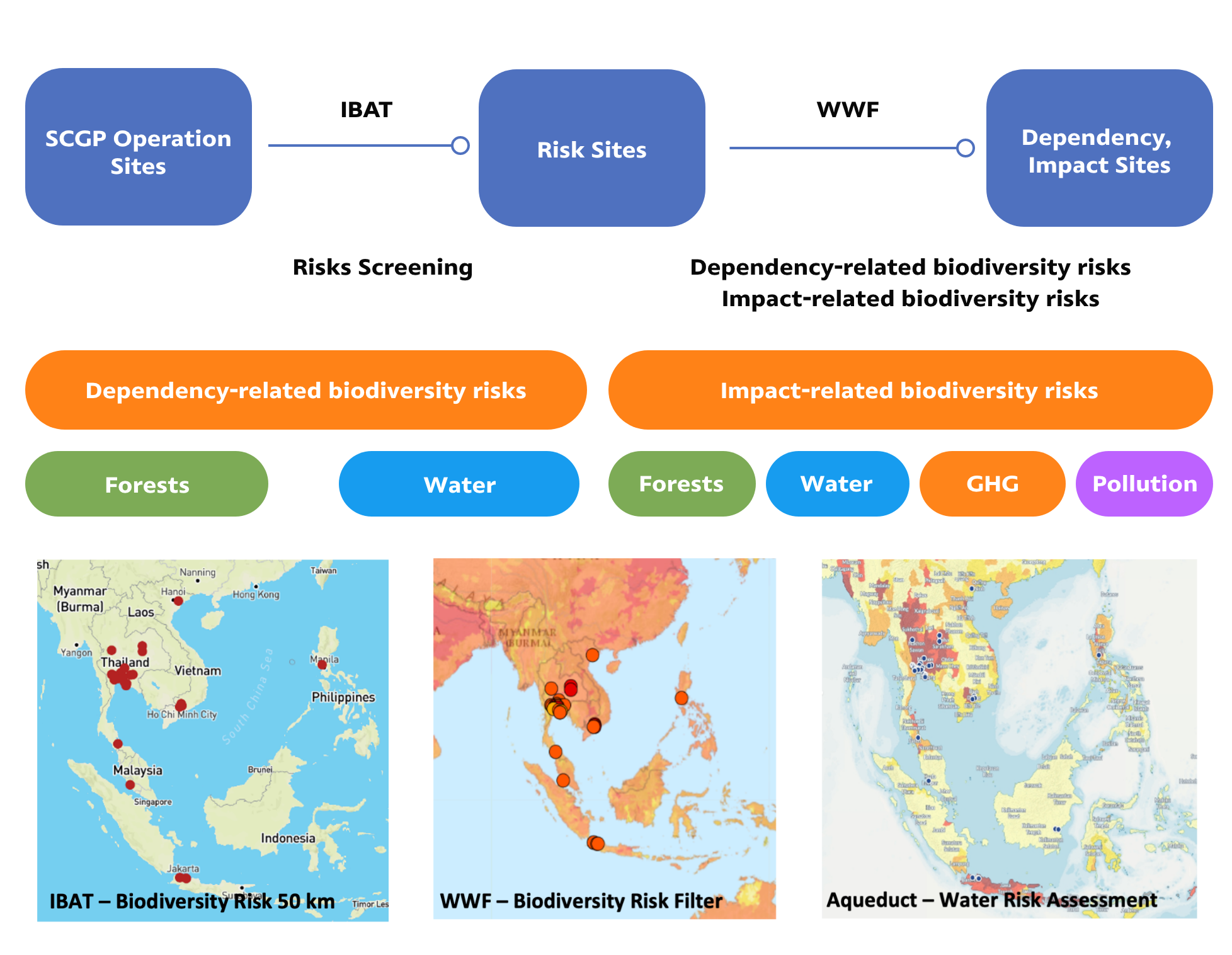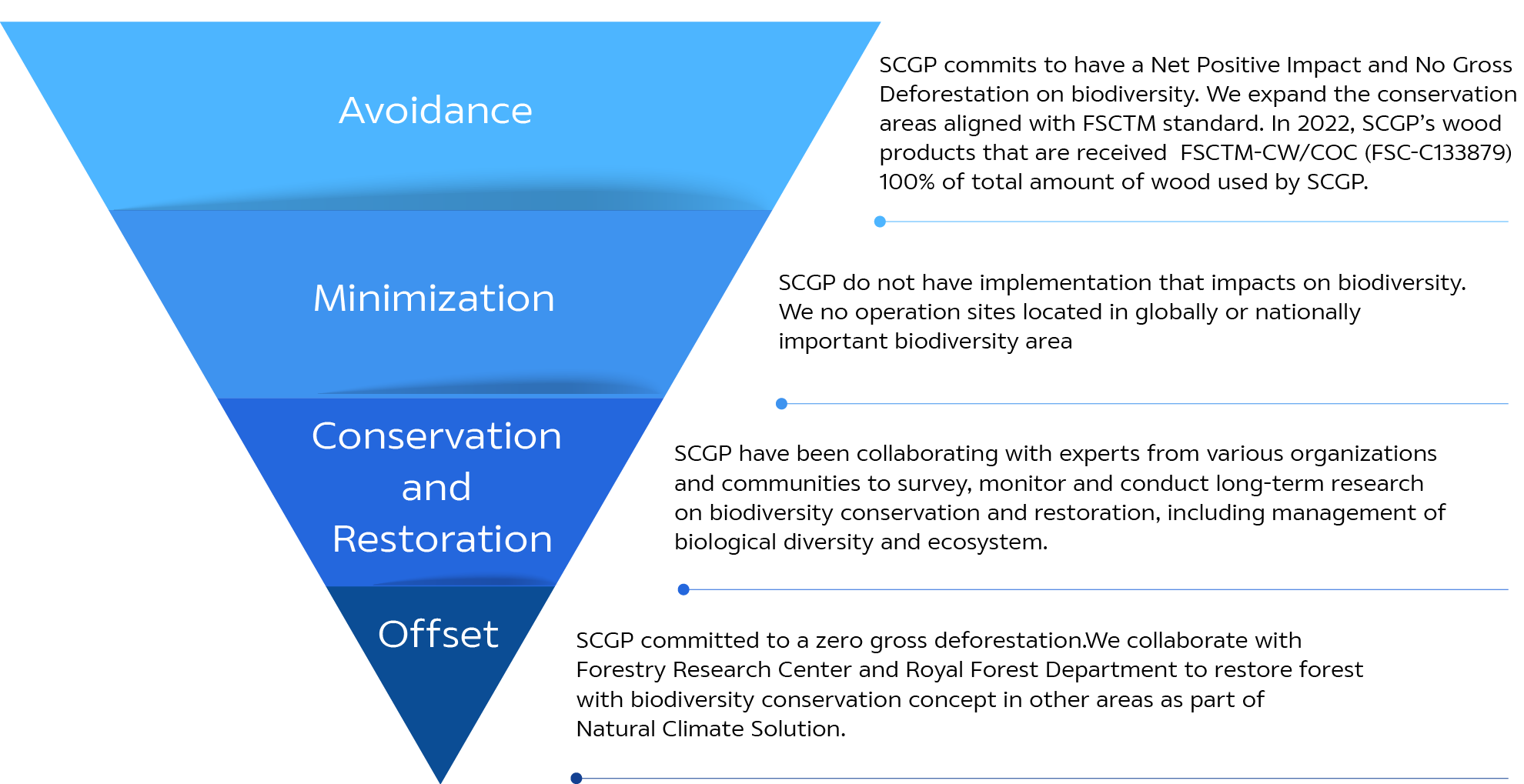Forestry and Biodiversity
SCGP has strong determination to maintain the ecosystem's balance by managing biodiversity and ecosystems according to the community's sustainability and conservation. We have been applying international indicators to benchmark our operations, intending to be a role model in biodiversity conservation.

Target
Performance 2023

SCGP sets targets and operates in line with “No gross Deforestation” throughout the supply chain, which covers SCGP operations is covering Supplier in tier 1 and Non-tier 1 in order to monitor executions and ensure that Biodiversity execution complies with Thai and international laws/regulations and standards, therefore SCGP has defined monitoring guidelines as per following:
- Internal : Setting up of FSCTM Management Committee in order to set execution guideline to be in line with policy strategy, and standard of forestry and biodiversity topic, especially FSCTM Standard.
- External : SCGP undertakes annual verification process by third party as follow;
2.1 Forestry Research Center : SCGP will be assessed in term of species, plants, animals according to the status of registered by the IUCN Red List (2011) and classified status by the Convention on International Trade in Endangered Species of Wild Fauna and Flora-CITES. ) highlighting the essence of the Convention for the Control of Exports and Imports or the commercial transfer of plant and animal species listed in Lists 1, 2 and 3 of the Convention for further compliance with the requirements.
2.2 FSCTM : SCGP will be assessed in form of executions and performances in accordance with the FSCTM Standard and cooperated with the communities to monitor and find measures to prevent operational risks
We assess nature-related impact and dependency, with a focus on identifying potential risks and opportunities in the future following the LEAP (Locate interface with nature/Evaluate dependencies and impacts/Assess risks and opportunities/Prepare to respond to nature-related risks and opportunities and report) approach proposed by TNFD, our analysis integrated Enterprise Risk Management process and framework that included policy & regulatory, technology, market, physical, and reputational risks.

1. Locate interface with nature
We meticulously mapped our business sites within a 50km, 10km, and 5 km radius, focusing on direct operations, upstream and downstream in the components of the suppliers, own operations, and customers.
SCGP has been assessed by using the IBAT program, which integrates 3 databases, including Protected Areas (PAs), Key Biodiversity Areas (KBAs), and IUCN Red List species, as part of their rapid screening of biodiversity-related risk and assess area of water stress.

2. Evaluate dependencies
After a thorough analysis of the area detected in the first step, we assess the potential impact of natural degradation in these areas, taking into account the degree of dependency (e.g., procurement volume, manufacturing volume) and analyze size and scale of our biological degradation impacts on the business and surrounding communities.
SCGP has collaborated with Forestry Research Center for evaluating and assessing of plant and animal species in SCGP’s conservation areas, based on the IUCN Red List (2011) and the status of trade between countries under the Convention on International Trade in Endangered Species of Wild Fauna and Flora (CITES), to execute align with regulatory requirements.

3. Assess risks and opportunities
For the “Access” step, SCGP has assessed risks and opportunities, and set plan to mitigate risks and increase opportunities. Water is a crucial resource for the operation of SCGP, SCGP track and map our plant water usage with a comprehensive water tool (such as Aqueduct) taking into account local water stress, the results are 0 % of sites are in water stress areas, and dependency on ecosystem services are water scarcity, forest and pollinator, including impact on water, forest and GHG.

4. Prepare to respond to nature-related risks and opportunities and report
In the “Prepare” step, the nature-related, together with other ESG issues, have been integrated into Enterprise Risk Management Framework in the part of operational risk that included Risks from Natural Resources and Environmental Management and Physical Risks from Climate Emergency. SCGP has set target and monitor performance of biodiversity related issue. The risks, opportunities and performances which relate to biodiversity, there are reported to the Risks management committee, Audit Committee and Environmental, Social and Governance (ESG) Committee on a quarterly basis. SCGP has set plan to manage biodiversity aligned with The Biodiversity Mitigation Hierarchy are included; avoid, reduce, restore, and transform. SCGP has committed to having a Net Positive Impact on biodiversity.
SCGP’s biodiversity risk assessment covers various critical areas to comprehensively understand and address potential impacts on nature. SCGP focuses on 4 key components:
Own Operations:
SCGP assesses the biodiversity risks associated with our own operations, ensuring that our activities promote conservation and minimize negative effects on ecosystems.
| Significant issues | Risk Management | Opportunity | Significant stakeholders | Importance to the 6 Capitals* |
|---|---|---|---|---|
| Forestry and Biodiversity |
|
|
|
|
* Reference is made to the value chain and the creation of sustainable value, as described by the 6 dimensions of the integrated reporting (IR) framework, which provides information that is linked to outcomes and impacts, as well as stakeholders throughout the value chain.
Adjacent Areas to Own Operations:
Recognizing the interconnectedness of ecosystems, SCGP considers risks and impacts from adjacent areas to own operations. So, SCGP extends assessment to adjacent areas near own operations within a 50 km, 10 km, and 5 km and meticulously mapped our business sites.
Upstream Activities (suppliers):
SCGP evaluates the biodiversity risks of upstream activities (suppliers). SCGP has raw materials from timber resource such as eucalyptus tree, pulp and paper. SCGP focuses on environmental friendly raw materials and aligned with global standard (Forest Stewardship CouncilTM). SCGP identifies and evaluates supplier’s activities on biodiversity, including corporate set mitigation plan to reduce any adverse effects on biodiversity.
Downstream Activities (customers):
Our assessment also includes downstream activities, considering the impacts of our products and services on biodiversity. SCGP works closely with customers to promote sustainable practices and encourage biodiversity conservation throughout product use and disposal.

We’re conscious of potential risks to nature and biodiversity from our business footprint, especially near wild and biodiversity-rich areas. Using TNFD-recommended tools like IBAT, WWF Biodiversity Risk Filter, and Aqueduct, we map our sites globally, ensuring responsible environmental stewardship. Together, we safeguard ecosystems and promote sustainable practices.
SCGP has no operation sites located in globally or nationally important biodiversity areas, including Thailand and International Protected Forest Area.
| Physical Risk | |
|---|---|
| Acute Risk |
|
| Chronic Risk |
|
| Water Scarcity |
|
| Riverine Floods |
|
| Urban Floods |
|
| El Niño and La Niña |
|
| Forest Risk |
|
| Transition Risk | |
| Policy and Legal |
|
| Market |
|
| Technology |
|
| Reputation |
|
| Systemic Risk | |
| Ecosystem Collapse |
|
| Aggregated |
|
| Contagion |
|


| Partner | Cooperation Activity |
|---|---|
| Forest Stewardship CouncilTM | - FSCTM is dedicated to promotion of responsible forest management worldwide |
| Forestry Research Center ,Kasetsart University | - Survey, study and research for long-term on biodiversity & ecosystem conservation and biodiversity management. |
| Faculty of Forestry ,Kasetsart University | - Support the experts about biodiversity management to give advise, knowledge and consult to the company. |
| Thai Forest Ecological Research Network ,Kasetsart University | - Monitor and give research knowledge in Long-term about conservation of biodiversity and ecosystems to company in order to develop Ecological Research |
| Forest resource management office, Royal Forest Department | - Promote conserve natural resources activities in the agroforestry area |


